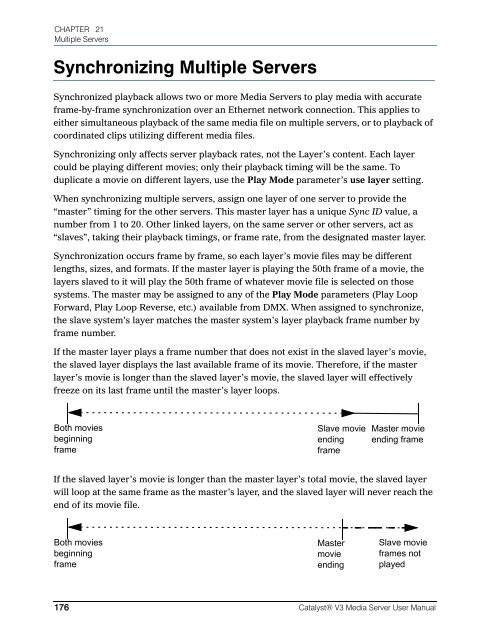Catalyst Manual - Cal Stage
Catalyst Manual - Cal Stage
Catalyst Manual - Cal Stage
You also want an ePaper? Increase the reach of your titles
YUMPU automatically turns print PDFs into web optimized ePapers that Google loves.
CHAPTER 21<br />
Multiple Servers<br />
Synchronizing Multiple Servers<br />
Synchronized playback allows two or more Media Servers to play media with accurate<br />
frame-by-frame synchronization over an Ethernet network connection. This applies to<br />
either simultaneous playback of the same media file on multiple servers, or to playback of<br />
coordinated clips utilizing different media files.<br />
Synchronizing only affects server playback rates, not the Layer’s content. Each layer<br />
could be playing different movies; only their playback timing will be the same. To<br />
duplicate a movie on different layers, use the Play Mode parameter’s use layer setting.<br />
When synchronizing multiple servers, assign one layer of one server to provide the<br />
“master” timing for the other servers. This master layer has a unique Sync ID value, a<br />
number from 1 to 20. Other linked layers, on the same server or other servers, act as<br />
“slaves”, taking their playback timings, or frame rate, from the designated master layer.<br />
Synchronization occurs frame by frame, so each layer’s movie files may be different<br />
lengths, sizes, and formats. If the master layer is playing the 50th frame of a movie, the<br />
layers slaved to it will play the 50th frame of whatever movie file is selected on those<br />
systems. The master may be assigned to any of the Play Mode parameters (Play Loop<br />
Forward, Play Loop Reverse, etc.) available from DMX. When assigned to synchronize,<br />
the slave system’s layer matches the master system’s layer playback frame number by<br />
frame number.<br />
If the master layer plays a frame number that does not exist in the slaved layer’s movie,<br />
the slaved layer displays the last available frame of its movie. Therefore, if the master<br />
layer’s movie is longer than the slaved layer’s movie, the slaved layer will effectively<br />
freeze on its last frame until the master’s layer loops.<br />
Both movies<br />
beginning<br />
frame<br />
If the slaved layer’s movie is longer than the master layer’s total movie, the slaved layer<br />
will loop at the same frame as the master’s layer, and the slaved layer will never reach the<br />
end of its movie file.<br />
Both movies<br />
beginning<br />
frame<br />
Slave movie<br />
ending<br />
frame<br />
Master<br />
movie<br />
ending<br />
Master movie<br />
ending frame<br />
Slave movie<br />
frames not<br />
played<br />
176 <strong>Catalyst</strong>® V3 Media Server User <strong>Manual</strong>



